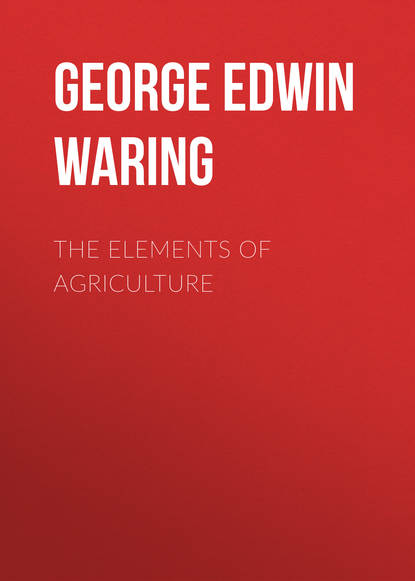По всем вопросам обращайтесь на: info@litportal.ru
(©) 2003-2024.
✖
The Elements of Agriculture
Настройки чтения
Размер шрифта
Высота строк
Поля
The depth of the drains must depend on the distances at which they are placed. If but twenty feet apart, they need be but three feet deep; while, if they are eighty feet apart, they must be five feet deep, to produce the same effect. The reason for this is, that the water in the drained soil is not level, but is higher midway between the drains, than at any other point. It is necessary that this highest point should be sufficiently far from the surface not to interfere with the roots of plants, consequently, as the water line between two drains is curved, the most distant drains must be the deepest. This will be understood by referring to the following diagram.
Fig. 7.
aa—5 feet drains, 80 ft. apart. bb—3 feet drains, 20 ft. apart.
The curved line represents the position of the water.
In most soils it will be easier to dig one trench five feet deep, than four trenches three feet deep, and the deep trenches will be equally beneficial; but where the soil is very hard below a depth of three feet, the shallow trenches will be the cheapest, and in such soils they will often be better, as the hard mass might not allow the water to pass down to enter the deeper drains.
By following out these instructions, land may be cheaply, thoroughly, and permanently drained.
CHAPTER III
ADVANTAGES OF UNDER-DRAINING
The advantages of under-draining are many and important.
1. It entirely prevents drought.
2. It furnishes an increased supply of atmospheric fertilizers.
3. It warms the lower portions of the soil.
4. It hastens the decomposition of roots and other organic matter.
5. It accelerates the disintegration of the mineral matters in the soil.
6. It causes a more even distribution of nutritious matters among those parts of soil traversed by roots.
7. It improves the mechanical texture of the soil.
8. It causes the poisonous excrementitious matter of plants to be carried out of the reach of their roots.
9. It prevents grasses from running out.
10. It enables us to deepen the surface soil.
By removing excess of water—
11. It renders soils earlier in the spring.
12. It prevents the throwing out of grain in winter.
13. It allows us to work sooner after rains.
14. It keeps off the effects of cold weather longer in the fall.
15. It prevents the formation of acetic and other organic acids, which induce the growth of sorrel and similar weeds.
16. It hastens the decay of vegetable matter, and the finer comminution of the earthy parts of the soil.
17. It prevents, in a great measure, the evaporation of water, and the consequent abstraction of heat from the soil.
18. It admits fresh quantities of water from rains, etc., which are always more or less imbued with the fertilizing gases of the atmosphere, to be deposited among the absorbent parts of soil, and given up to the necessities of plants.
19. It prevents the formation of so hard a crust on the surface of the soil as is customary on heavy lands.
How does under-draining prevent drought?
1. Under-draining prevents drought, because it gives a better circulation of air in the soil; (it does so by making it more open). There is always the same amount of water in and about the surface of the earth. In winter, there is more in the soil than in summer, while in summer, that which has been dried out of the soil exists in the atmosphere in the form of a vapor. It is held in the vapory form by heat, which acts as braces to keep it distended. When vapor comes in contact with substances sufficiently colder than itself, it gives up its heat—thus losing its braces—contracts, and becomes liquid water.
This may be observed in hundreds of common operations.
Why is there less water in the soil in summer than in winter, and where does it exist?
What holds it in its vapory form?
How is it affected by cold substances?
Describe the deposit of moisture on the outside of a pitcher in summer.
What other instances of the same action can be named?
It is well known that a cold pitcher in summer robs the vapor in the atmosphere of its heat, and causes it to be deposited on its own surface. It looks as though the pitcher were sweating, but the water all comes from the atmosphere, not, of course, through the sides of the pitcher.
If we breathe on a knife-blade, it condenses in the same manner the moisture of the breath, and becomes covered with a film of water.
Stone houses are damp in summer, because the inner surfaces of the walls, being cooler than the atmosphere, cause its moisture to be deposited in the manner described. By leaving a space, however, between the walls and the plaster, this moisture is prevented from being troublesome.
How does this principle affect the soil?
Explain the experiment with the two boxes of soil.
Nearly every night in the summer season, the cold earth receives moisture from the atmosphere in the form of dew.
A cabbage, which at night is very cold, condenses water to the amount of a gill or more.
The same operation takes place in the soil. When the air is allowed to circulate among its lower and cooler particles, they receive moisture from the same process of condensation. Therefore, when, by the aid of under-drains, the lower soil becomes sufficiently open to admit of a circulation of air, the deposit of atmospheric moisture will keep the soil supplied with water at a point easily accessible to the roots of plants.
If we wish to satisfy ourselves that this is practically correct, we have only to prepare two boxes of finely pulverized soil, one, five or six inches deep, and the other fifteen or twenty inches deep, and place them in the sun at mid-day in summer. The thinner soil will be completely dried, while the deeper one, though it may have been perfectly dry at first, will soon accumulate a large amount of water on those particles which, being lower and more sheltered from the sun's heat than the particles of the thin soil, are made cooler.
With an open condition of subsoil, then, such as may be secured by under-draining, we entirely overcome drought.
How does under-draining supply to the soil an increased amount of atmospheric fertilizers?
How does it warm the lower parts of the soil?
2. Under-draining furnishes an increased supply of atmospheric fertilizers, because it secures a change of air in the soil. This change is produced whenever the soil becomes filled with water, and then dried; when the air above the earth is in rapid motion, and when the comparative temperature of the upper and lower soils changes. It causes new quantities of the ammonia and carbonic acid which it contains to be presented to the absorbent parts of the soil.






